
Features
Crop Culture
Inputs
Growing Points: Understanding pH and EC
March 10, 2014 By Dr. Mohyuddin Mirza
I delivered presentations at two bedding plants workshops in Alberta this past January and February.
I delivered presentations at two bedding plants workshops in Alberta this past January and February.
One of the talks was on common issues in bedding plant production. When I started thinking as to what I should show and tell new growers, managing pH and EC were at the top of the list.
We have talked about these two topics on numerous occasions, and extensive research has been conducted and reported. However, there is still a problem with pH and EC management of crops grown in greenhouses.
The reason appears to be a lack of clarity on what pH is. Some growers feel it is too scientific when we talk about hydrogen ions and hydroxyl ions and then encourage them to invest in a good pH and EC meter and maintain and calibrate them regularly. Let us look at these pictures:
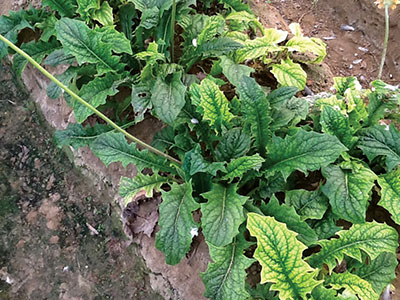 |
|
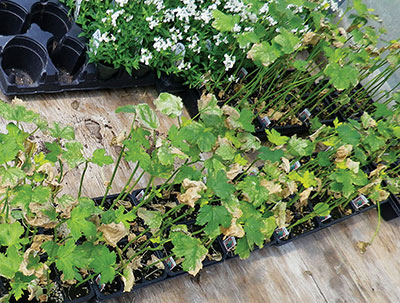 |
This is a soil-grown crop of gerberas in India (above). The grower wanted to know what the problem was and how to correct it. It is a deficiency of iron, most likely caused by an alkaline pH. My guess is that the pH in this case was over 7.0. The grower did not have a pH meter to check this.
In Canada, I have seen gerbera crops being grown in soil but mostly in soilless growing systems. I consider gerberas to be in the category of iron inefficient plants and will show iron deficiency when the pH starts going towards the alkaline side.
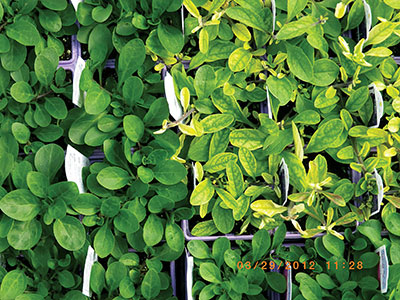 |
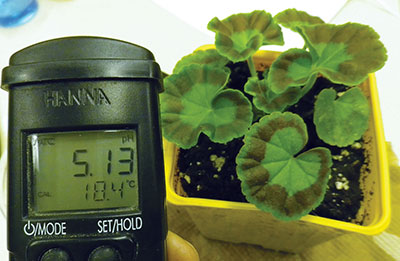
|
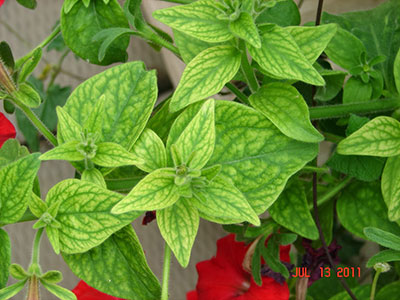 |
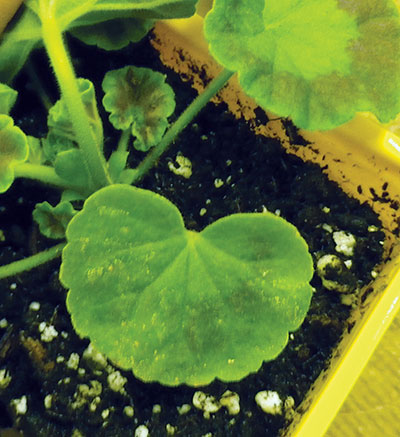
|
This second picture (above) has a story behind it and it’s a pH story! With the growing interest in ethnic vegetables, many growers began trialling okra plants. Many soon gave up because all too often the lower leaves developed severe necrosis and the plants could not reach the flowering and fruiting stages.
Dr. Kwesi Ampong-Nyarko, my good friend and colleague at the Crop Diversification Centre of Alberta Agriculture, Food and Rural Development, has been studying this crop for commercial culture and never saw this problem until last year when he used a different soilless growing medium. We observed the same problem on young seedlings. That is when we discovered that okra just “hates” a pH of below 5.5 and this particular growing medium did not have enough lime in it!
Among bedding plants, petunias are the first to show signs of iron chlorosis both at the plug stage and in advanced hanging baskets. The fertilizing program generally has enough iron and manganese in it and deficiency symptoms are due to pH going over 6.5 in soilless growing media.
The picture on top is an interesting one in which side-by-side cell packs containing the same batch of growing medium are showing no deficiency of iron on plants on the left side and deficiency symptoms on plants on the right side. I think it is very likely due to poor mixing of lime when the growing medium was prepared.
The pH on the left side was around 6.0 and on the right side it was 6.8.
In the picture below it, the pH was 6.6. From a practical and a non-destructive point of view, I use the pour-through leach method. (There are other methods, such as preparing a saturation paste and filtering the water through and taking the reading.)

|
|
This is how the pour-through method is done.
Take good quality water or distilled water and pour it through the container. Collect enough water from the saucer so that an electrode can be dipped in properly. Avoid over-leaching if the same water is used both for measuring pH and EC.
The second picture in this series of three shows an actual measurement from a geranium container showing some speckling on lower leaves. You can see those specks on the leaves in the third picture. It confirmed that the pH was 5.13 and those specks were due to an accumulation of iron.
I encourage growers to take pH and EC readings on a scheduled basis. Assign a dedicated person to take these measurements and include hanging baskets as well. During the rapid growth season, readings should be taken at least twice a week.
Prepare a graph so that monitoring can be done.
Remember that since pH is measured on a logarithmic scale, it will take longer to change those levels.
Each increment of pH has 10 times more hydrogen ions than that of the previous increment. That is the confusing part, because we are used to simple additive math. In the case of pH, it is a factor of 10. What it means is that if a certain amount of acid is required to bring the pH down from 7 to 6, then the same amount of acid will not bring the pH down from 6 to 5. It all depends upon the amount of carbonates and bicarbonates present in water and in the growing medium.
There are basically two pH-related situations that need to be corrected – acid and alkaline situations.
I would like to point out that the term “alkalinity,” which is frequently seen in analytical reports, is not a measurement of pH. Alkalinity is a measurement of total carbonates or bicarbonates that are present in water or growing medium. It is reported as parts per million (ppm), milligrams/L, or as milliequivalent/L. The higher the level of carbonates and bicarbonates, the more alkaline the pH will be.
WHAT TO DO WHEN pH IS ON ACIDIC SIDE
- Use potassium bicarbonate.
If you started noticing problems with geraniums at a pH of 5.0, then it will take at least three weeks to raise the pH to 6. Don’t apply any fertilizer; use the potassium bicarbonate alone. Resume fertilizing once pH is adjusted to the desired level.
- Avoid the use of fertilizers with higher levels of ammonium nitrogen compared to nitrate nitrogen.
Ammonium-based fertilizers contribute towards acidity in the growing medium, thus worsening the situation.
- If you know that your water has higher bicarbonates, then irrigating with water alone for some time may be helpful.
I have seen some growers start using calcium nitrate because potassium bicarbonate was not in stock.
And please don’t do this!
What you see in the picture below is the result of using incorrect rates of iron sulphate that were posted on the Internet. One can find the rate of one pound of iron sulphate per 100 gallons, and that is what caused so much damage to the leaves of these young petunia plants. Foliar feeding of iron may help, but remember to only use the proper rates!
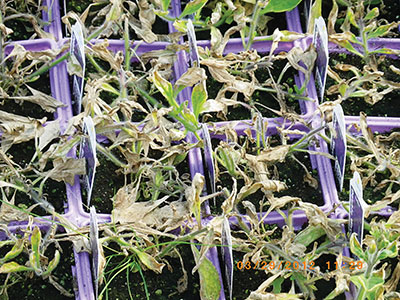
|
|
WHAT TO DO WHEN pH IS ON ALKALINE SIDE
- Apply a fertilizer solution with a pH of around 5.8.
I have seen growers use a solution pH of 5.5 as well. Choose your acids wisely. Choice should be based on what will work in your situation. Make sure that you know how much acid needs to be used and how to use it. Many growers inject acid into a water-holding tank and others use in-line injectors. Don’t add phosphoric acid into a calcium nitrate stock tank.
- I do recommend growers use fertilizers which are acidic in nature. Ammonium nitrate or high ammonium to nitrate ratio fertilizers can be used.
EC is an abbreviation of Electrical Conductivity, and it is measured by an EC meter. The measurements are in millisiemens or millimhos. I have written before on this topic. Please check March 2012 and March-April 2013 issues of Greenhouse Canada, for some refresher points about EC.
Most bedding plants are “happy” with a leach EC of between 2.0 to 3.0 measured with the pour-through method.
Monitor the EC regularly and do some leaching with every watering.
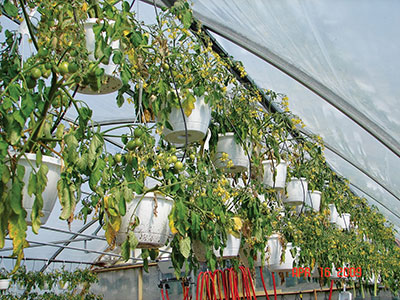
|
|
Monitor hanging baskets more closely for EC levels. It can rise very quickly because they are located in an area of the greenhouse where light is high, temperature is high and humidity is dry, especially in Alberta. The EC can go over 5.0 mS very quickly.
EC can rise quickly if you are using sub-irrigation. During the season you may have to leach from the top.
Here are tomato plants in hanging baskets in which the EC went over 5.0 mS on some bright April days. The plants were on a constant feed program with an EC of 2.5 mS.
Dr. Mohyuddin Mirza is a greenhouse consultant. • drmirzaconsultants@gmail.com
Print this page